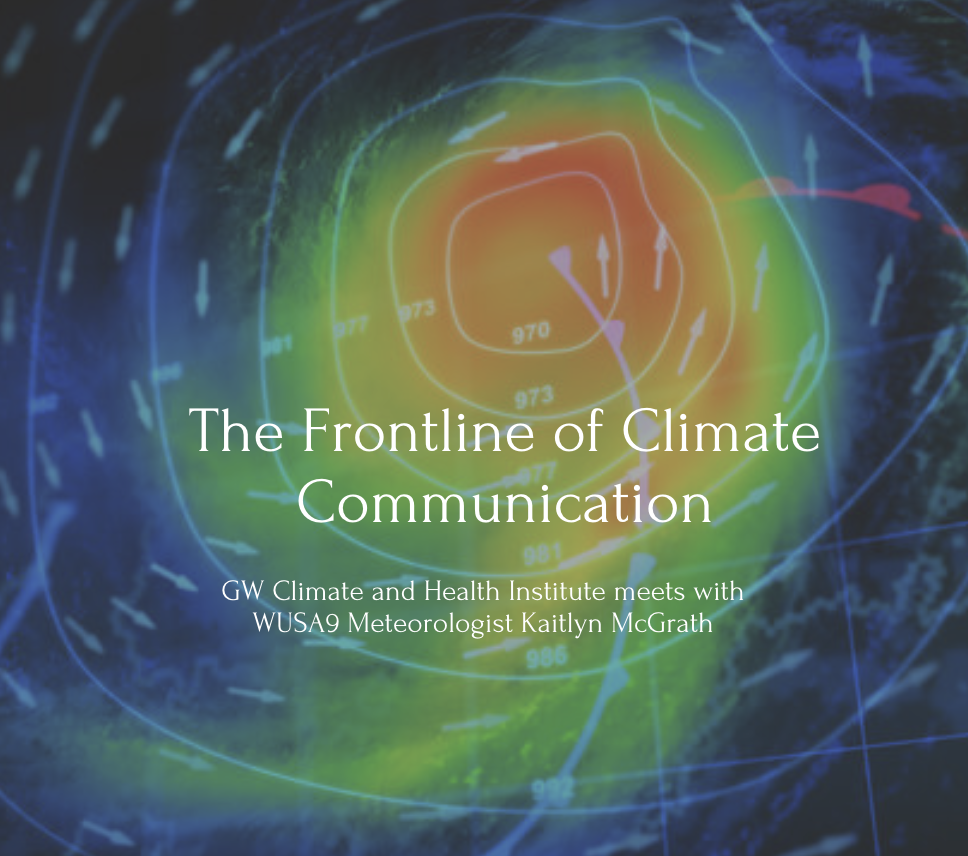The George Washington University’s Milken Institute School of Public Health and the GW Climate & Health Institute emphasize educating the public of the critical nexus between climate change and public health. Doing so requires consideration of how complex and politicized topics such as climate change are communicated to the public. That delicate task often falls to meteorologists. Thus, the Institutes have often found their work aligned with that of WUSA9 meteorologist Kaitlyn McGrath.
Kaitlyn is a broadcast meteorologist who has spent the last three years working in Washington DC. In the newsroom, she covers the daily weather for the DC region, as well as covering stories surrounding climate change and how it can affect the local community. During this time she has had the opportunities to interview and work with GW professors Dr.Dan Goldberg, Dr.Neelu Tummala, and many others within the CHI. This past March, she was invited to campus to speak on the current state of working in climate communication. The focus of the event was to educate students about the ever-evolving role of meteorologists and to examine how social media and new channels of communication are impacting the spread of information.
Kaitlyn McGrath and CHI program manager Katie O’Donnell both believe that by using real and local examples of climate change, average people can better understand how this issue affects their lives. Local topics not only keep people informed but also invested in making choices that help their communities. Climate change has been heavily politicized, but by taking the focus away from the polarization and looking just at its effects at the community level Kaitlyn is able to begin conversations on how we can help our communities.
Climate communication has become a primary role of meteorologists as their role within the newsroom evolves. More and more people use weather apps to check the daily temperature and weather, which has allowed meteorologists to expand their focus to topics that differ from daily weather patterns, including the effect of climate change on their local environment. With more coverage on these topics, broadcasters can spread this crucial information to a larger audience, both those who watch television news and by branching out onto the internet
A key piece of Kaitlyn’s discussion with GW students in March was informing them how the internet is changing communication. Television news stations have gone from one audience to many by spreading content onto station-specific apps and websites, as well as using social media including Instagram, TikTok, Facebook, X (formerly Twitter), and YouTube. Students studying communication or the environment who hope to go into reporting not only need to examine what will make a good story and provide thought-provoking information but also what content on social media has clickability and can draw in readers. Another key consideration when researching for a story is if the content can be adapted into short-form content.
Short-form content dominates social media with content that is between 30-60 seconds in length. This type of content primarily began on TikTok before spreading to Instagram, Facebook, and YouTube. The goal of this content is to hook viewers in before they scroll to the next video while delivering as much information as possible. The drawback of this content is in its ability to rapidly spread misinformation. Misinformation significantly impacts heavily politicized topics like climate change leaving viewers confused about the truth; however, reputable news stations can also create content to stop the spread of misinformation.
Kaitlyn’s work to spread important climate-focused communication has allowed the general public to have a better understanding of climate change in their community. If you are interested in Kaitlyn’s work or want to hear Dr.Tummala’s explanation for why seasonal allergies in DC are worse this year check out Kaitlyn’s article "How seasonal allergies are being impacted by climate change" below.
How seasonal allergies are being impacted by climate change


